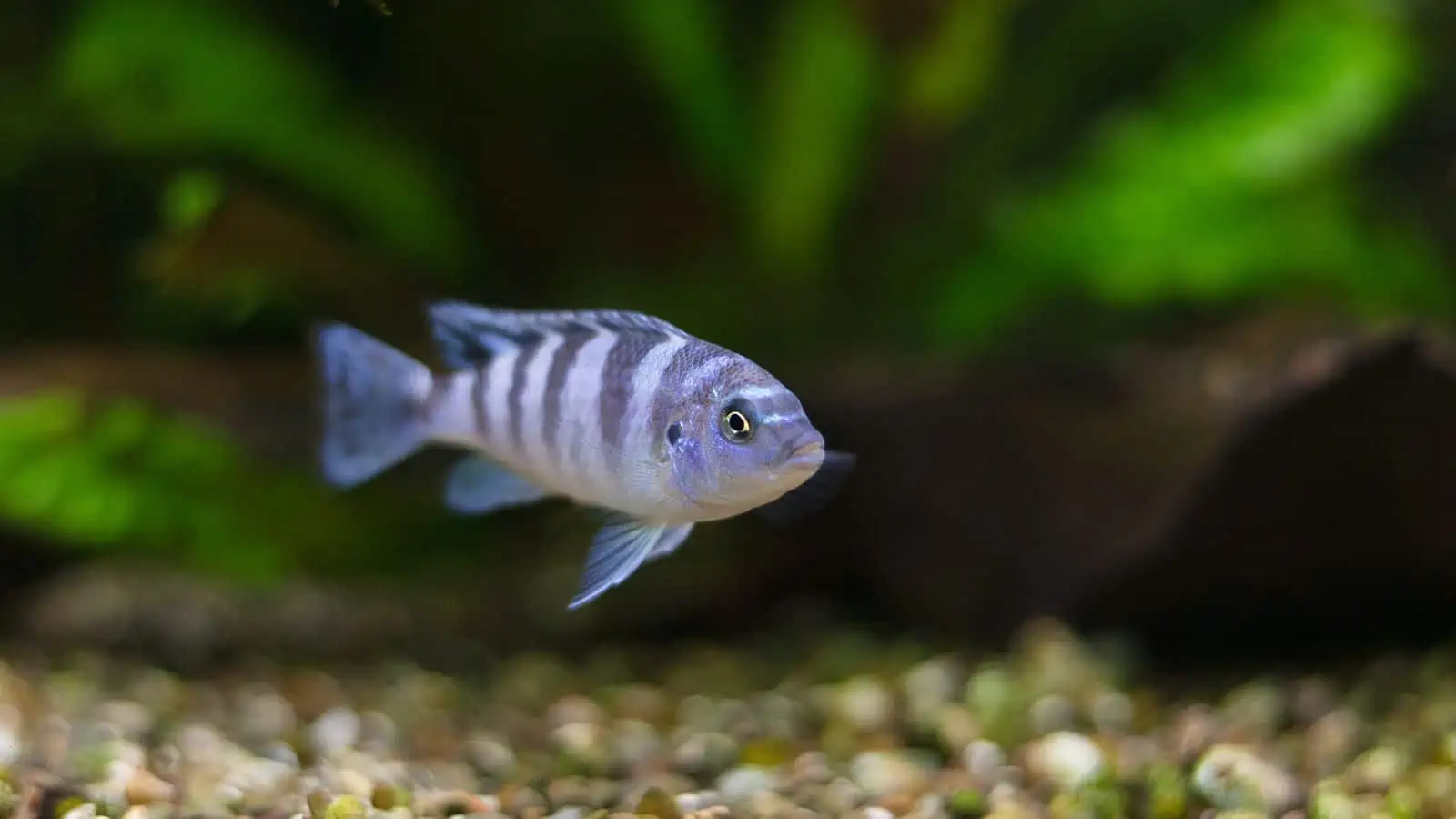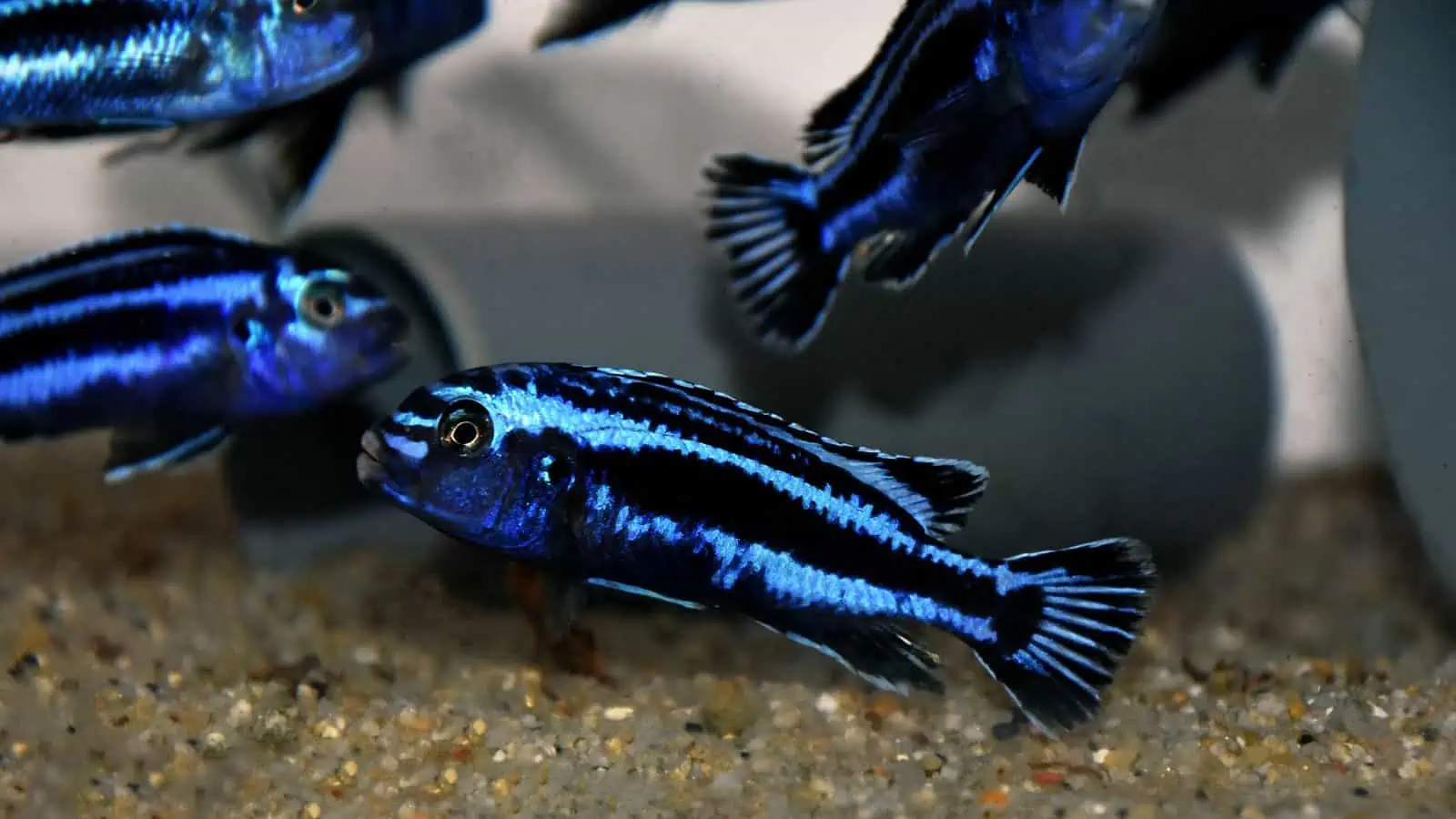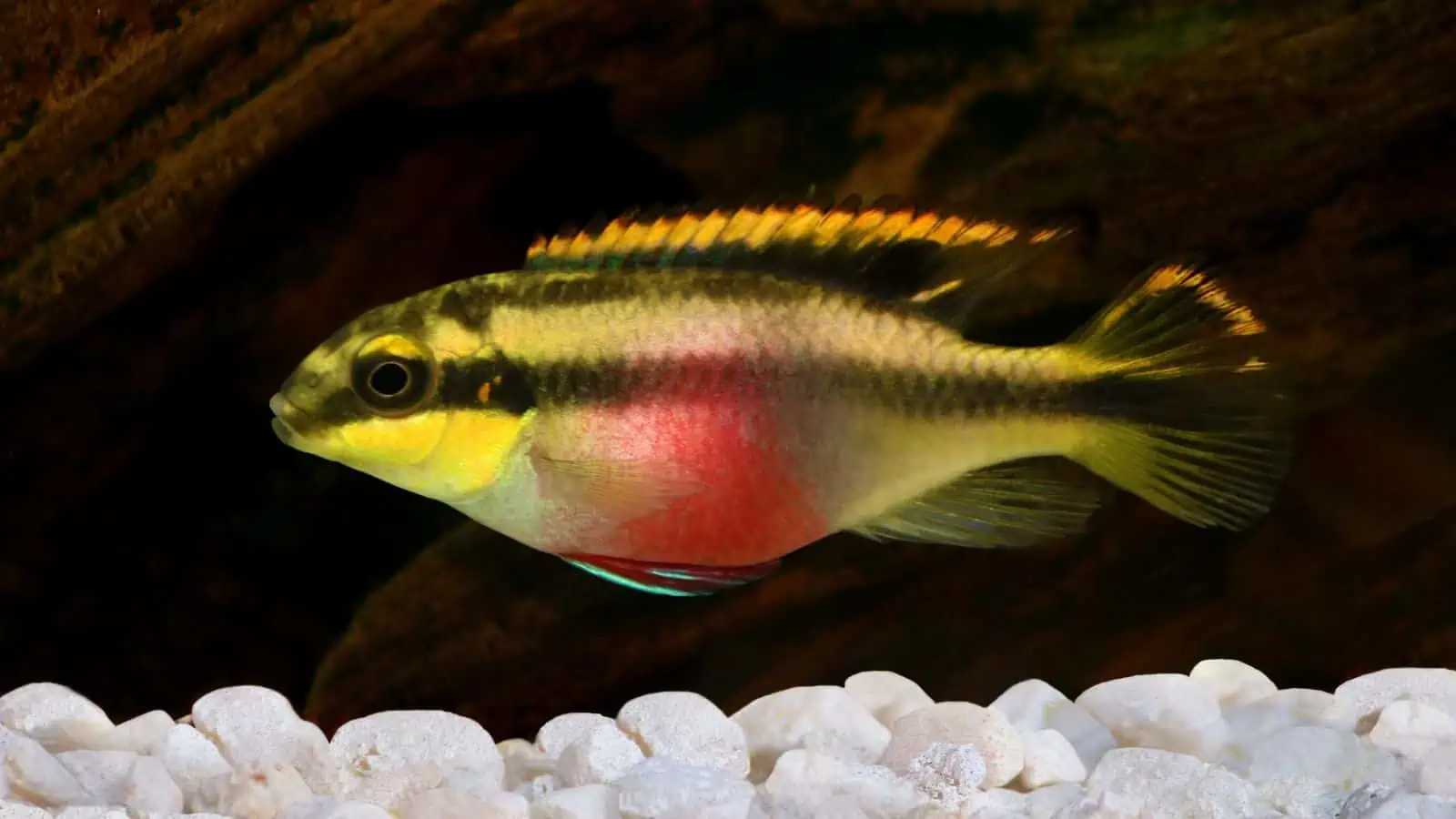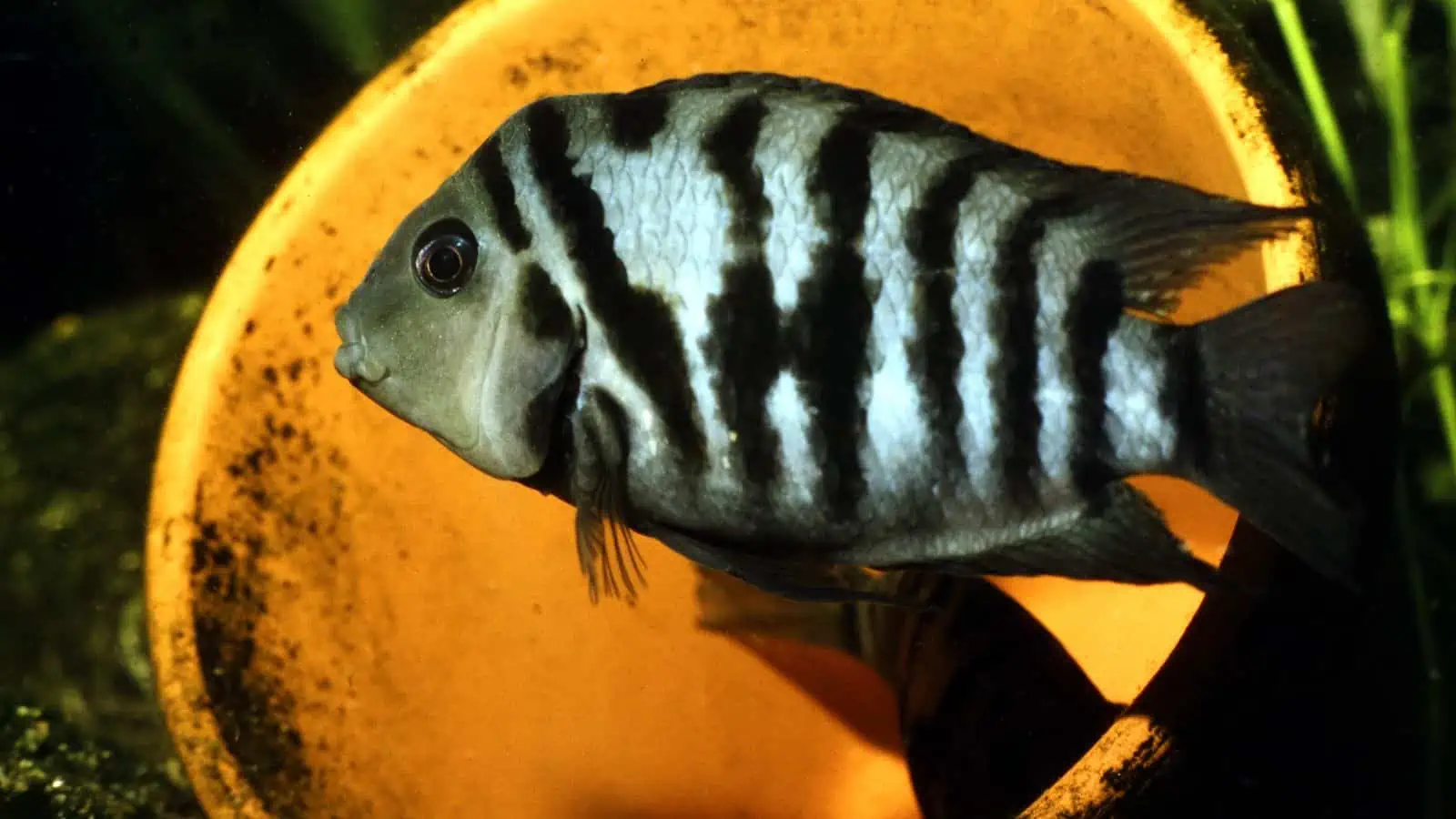Cichlids are a hugely popular tropical fish with many fish keepers. However, this species needs quite a lot of space in the tank, and they can be territorial and semi-aggressive.
But just how much space do cichlids need to be peaceful and thrive? You might think that a 55-gallon aquarium is plenty big enough to house quite a few of these beautiful fish, but that all depends on a number of factors.
There are so many different species of cichlids that it’s next to impossible to give you a definitive answer on how many can fit in a 55-gallon aquarium.
As a general rule of thumb, cichlids need AT LEAST two gallons of water per inch of fish, although that does vary depending on the species you want to keep.
Read this guide to learn more about how many of each of the most popular species of cichlids you can keep in a 55-gallon tank.
How Many Cichlids Can Live in a 55-Gallon Tank?
The number of cichlids you can keep in a 55-gallon tank varies tremendously depending on the species and its temperament.
However, if your fish are between 3 and 4.5 inches long, you can keep around 4 to 6 individuals in your 55-gallon cichlid tank. If the fish are smaller than that, you still need to allow plenty of space per fish, but it’s possible to keep between 10 and 15 cichlids in a tank of that size.
That assumes the fish have a relatively peaceful temperament and aren’t an aggressive variety, so you need to do plenty of research before assembling your cichlid community.
Remember that the bigger the tank you have, the better it will be for the welfare and health of your cichlid community.
Cichlid Size and Aquarium Size
As I mentioned earlier, there are many different species of cichlids that you can keep in a home aquarium.
Later in this article, I’ll give a rundown of the most popular species and their spatial requirements, but for now, the basic rule of thumb to know is that every inch of cichlid needs at least two gallons of water as an absolute minimum.
According to that rule, a 6-inch cichlid needs at least 12 gallons of tank space, although research shows that this is still a bit small, and most cichlid keepers would agree that’s the absolute minimum you should allow. In fact, if you have a 6-inch cichlid, you should keep it in a 20-gallon tank as a minimum.
On that basis, you can see that you could keep two or three fish of that size in your 55-gallon tank. If you have larger cichlids of around 8 inches long, you could keep two of them in a 55-gallon tank, but three would be too many.
Territorial Behavior and Aggression
If you haven’t kept cichlids before, one very important point to note is that these fish are usually semi-aggressive and territorial. For that reason, the more space you can give them, the better, especially if you’re keeping multiple species of cichlids in the same tank.
At the very least, you should allow 2 gallons of water per 1 inch of fish, although somewhere between 3 and 3.5 gallons per inch is much better.
However, you must remember that not all cichlid species are the same, so be ready to do plenty of research before you buy.
Cichlid Care Tips
Despite their popularity, cichlids aren’t the easiest fish species to care for, and there are a few things you need to know about them before you start fish shopping!
Lifespan
On average, most types of cichlid can have a life expectancy of around ten years, so you need to be aware that you’re making quite a large commitment when you choose this species.
Space
Cichlids love to hide in established territories, so you’ll need to have a tank with plenty of caves, hollow logs, beneath pieces of driftwood, and under rocky overhangs.
These fish also enjoy an environment with lots of bushy aquarium plants to explore, so the ideal tank size will be big enough to accommodate those requirements.
For that reason, your fish tank setup needs plenty of space and should be set up to relieve the stress associated with the fish’s territorial behavior.
Managing Aggression
Some species of cichlids don’t make the best choice for a community tank, as they can be somewhat aggressive and might eat smaller, shy fish.
For that reason, I recommend keeping cichlids with fish that are larger than themselves or with other cichlid species that will give as good as they get.
Quiet Time
Some cichlid species are easily startled and stressed, and they can be very sensitive to fluctuations in water parameters. For that reason, I recommend keeping your tank in a low-traffic area that’s well away from drafts, direct sunlight, loud noises, and vibration.
Dirty Fish!
Large cichlids eat a lot, and they create a lot of waste as a result. For that reason, you need a strong filtration system in your tank that can handle at least four times the volume of water in your aquarium every hour.
In addition, you need to perform regular water changes to keep the tank clean and safe for your fish and keep the filter media and unit well-maintained.
Water Chemistry and Parameters
Most cichlid species are pretty sensitive regarding water chemistry and parameters, so you’ll need to ensure that the conditions in your fish tank are suitable for the species you have opted to keep.
When choosing cichlids, be sure to check that each species shares the same basic requirements when it comes to temperature, pH level, and water hardness. Fit a reliable heater with a thermostat, and use an accurate digital aquarium thermometer that’s easy to read to check the water temperature daily.
Use a reliable aquarium water testing kit to check the water chemistry every week, and take whatever action is necessary to correct imbalances.
15 Popular Cichlid Species for a 55-Gallon Tank
Now, here is an overview of 15 popular cichlid species that can live comfortably in a 55-gallon tank.
Remember that 55 gallons is the recommended minimum tank size for these fish and is not necessarily ideal, and in all cases, a bigger tank would be even better.
Cobalt Blue Zebra Cichlid (Maylandia callainos)

This type of cichlid generally grows to reach around 6 inches long and needs roughly 50 gallons of water per fish. There’s also a Red Zebra cichlid variety that’s slightly smaller at around 5 inches long and does very well in a 50-gallon tank.
Mbuna Cichlid (Maylandia zebra)

The Mbuna cichlid grows to reach around 5 inches long and needs at least 55 gallons of space to be happy.
Albino/Red/Yellow Peacock Cichlid
All these cichlid species grow to reach around 5 inches in length and need roughly 55 gallons of aquarium space to be comfortable.
When you go shopping for your fish, you should know that, despite their similarities, all three varieties of Peacock cichlid are actually different species.
Blue Peacock Cichlid (Aulonocara nyassae)

Blue Peacock cichlids can grow to measure 7 inches long and need at least 55 gallons of space for just one fish.
Electric Blue Cichlid (Sciaenochromis fryeri)

Electric Blue cichlids are one of the largest species for home tanks, potentially growing to reach 8 inches long.
A 55-gallon tank is really too small for one of these fish, although you could grow on a juvenile specimen in a tank of that size, provided you intend to transfer the fish to a more spacious aquarium once it’s fully mature.
Electric Yellow Cichlid (Labidochromis caeruleus)

If you want to keep a fish that adds a spectacular pop of color to your tank, the Electric Yellow cichlid grows to around 5 inches long and will be comfortable in a 50-gallon tank.
Demasoni Cichlid (Pseudotropheus demasoni)

This beautiful dark blue and black cichlid measures just 3 inches long, making it an ideal candidate for a large 55-gallon tank.
Maingano Cichild (Melanochromis cyaneorhabdos)

The Maingano cichlid is an unusual variety that you don’t often see in the home tank, which is a shame, as this is a beautiful fish that grows to around 5 inches long, making it ideal for a 50-gallon tank.
Acei Cichlid (Pseudotropheus acei)
The unusual Acei cichlid Typically reaches around 6 inches long and therefore needs a minimum size of a 55-gallon tank to be comfortable.
Kribensis Cichlid (Pelvicachromis pulcher)

Kribs are fascinating little cichlids that don’t grow much bigger than 4 inches long. I kept a male and female pet of these guys in my tropical community tank and loved watching them spawning and raising their brood of tiny fry.
Angelfish (Pterophyllum scalare)

Angelfish are elegant, common triangular-shaped fish that come in several color variants. These relatively peaceful cichlids typically grow to around 3 inches long and 6 inches tall and can do well in pairs or small groups in a 55-gallon tank.
German Blue Ram (Mikrogeophagus ramirezi)

Rams are small, colorful cichlids that can make a wonderful addition to a community setup. these are generally peaceful fish but require very stable water conditions to thrive.
These fish only reach 2 to 2.5 inches long, so you can keep quite a few of them in a 55-gallon setup.
Keyhole Cichlid (Cleithracara maronii)

These small cichlids are so named for the distinctive keyhole-shaped marking on their bodies.
Keyhole cichlids are relatively peaceful creatures that generally do well in community tank setups, growing to just under 5 inches long, so they are a good choice for your 55-gallon aquarium.
Convict Cichlid (Amatitlania nigrofasciata)

Convicts are active cichlids that are hardy and adaptable, tolerating a wide range of water conditions and having an attractive black-and-white stripe pattern on their bodies.
These fish typically grow to between 4 and 6 inches long, making them ideal candidates for life in a 55-gallon fish tank.
FAQs
In this part of our guide, we answer some of the most frequently asked questions regarding how many cichlids can live in a 55-gallon tank:
Q: What cichlids can go in a 55-gallon tank?
A: A 55-gallon aquarium provides plenty of space for keeping cichlids. Various species will thrive in a tank of this size, including the following:
- Angelfish (Pterophyllum scalare)
- German Blue Ram (Mikrogeophagus ramirezi)
- Electric Yellow Cichlid (Labidochromis caeruleus)
- Keyhole Cichlid (Cleithracara maronii)
- Kribensis (Pelvicachromis pulcher)
- Convict Cichlid (Amatitlania nigrofasciata)
Remember that some species of cichlid can be quite aggressive, so be sure to do plenty of research before you buy your fish.
Q: Can Oscars live in a 55-gallon tank?
A: Unfortunately, Oscar’s grow too large to live in a 55-gallon tank. Ideally, you want a tank of at least 75 gallons to accommodate one of these huge fish.
Q: How big a tank do I need for four African cichlids?
A: Depending on the species of cichlids you want to keep, you will need a tank of at least 40 gallons to accommodate four fish.
Final Thoughts
I hope you enjoyed this article explaining how many cichlids can live in a 55-gallon tank. If you did, please take a moment to share the article with other cichlid enthusiasts!
Most cichlid species need at least two gallons of water per inch of fish to be comfortable. However, that’s just a basic rule of thumb, and the size of the tank you need is dependent on the species’ temperament and behavior as well as its size.
When shopping for any fish species, always remember that most of the specimens you see for sale in your local fish store and online are juveniles that will grow considerably larger when they mature. For that reason, it’s essential that you do plenty of research into each species before you part with your cash and take the fish home.
What species of cichlids do you keep, and what size aquarium do you have for them? Tell us about your fish in the comments box below!


